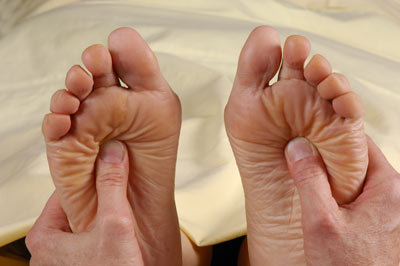
Plantar fasciitis or plantar heel pain syndrome (PHPS)
Search Massage Therapists in your Area
Plantar fasciitis or plantar heel pain syndrome (PHPS) is a painful and debilitating condition. There has been little if any progress in finding effective clinical treatments and suffers are left to find alternative ways of dealing with the pain, so massage therapy for plantar fasciitis is becoming increasingly popular alternative, mainly due to its non-invasive nature, but also because of growing scientific evidence of its ability to produce positive results.
Understanding plantar fasciitis
Plantar fasciitis is generally understood as inflammation of the band of tissue that stretches from the heel of the foot to the middle foot bones and supports the arch of the foot, acting as a shock-absorber; very useful if you are on your feet all day or run over hard surfaces regularly. The inflammation and associated pain is believed to be caused by injury to the fascia, usually close to the heel bone. People who go from a sedentary lifestyle to lots of exercise involving the feet are at the highest risk. Other risk factors include poor footwear, being overweight, not warming up before exercise and accidents.
How debilitating can the condition be?
In many cases, the pain is moderate and after a short period of rest it eases and even fades away completely, and some sufferers find that returning to more strenuous exercise increases the amount and frequency of the pain. At the other end of the scale are those who remain in pain despite rest and whose ability to walk without pain is severely impaired. In addition, they may develop a limp to try and reduce the pain and discomfort while moving. In the worst cases, the pain develops in both feet at the same time.
What are the current prescribed treatments?
Rest is always the first course of action suggested for plantar fasciitis. Anti-inflammatory drugs or creams may also be prescribed to alleviate the pain. Additionally, ice packs can be used to help deal with pain and aid in calming inflammation and swelling. Where the pain continues, medical practitioners may suggest steroid injections to reduce inflammation. However, these do not always work, are painful to have administered and are not without side-effects. It is not unusual for patients to undergo a course of two to three injections over a number of weeks.
Massage Therapy for Plantar Fasciitis
Muscles and tissues within the body do not work alone. They are all connected together, and if they weren’t then bodies would not work in a very coordinated fashion. However, this very point means that a problem in one area can cause difficulties in another. Anyone who has ever experience ‘brain freeze’ after eating or drinking something very cold can attest to this point. Plantar flexor muscles are related to the issue. If these muscles become shortened, over tensed or damaged, additional stress is put on the plantar fascia, increasing the risk of injury or inflammation. Working with this theory, the opposite should also be true and supporting the muscles in the calf through massage would have a positive, even restorative, effect on the plantar fascia and associated pain and inflammation. Massage helps spread out the fibers of the plantar muscles and increases blood flow through the entire foot. Done consistently and complemented by rest, anti-inflammatories and ice, a full recovery can be made over time.
Scientific proof for massage therapy
A single-blind randomized study, published in Manual therapy in 2013, was one of the first of its kind to provide a scientific basis for the use of massage therapy to relieve the pain and inflammation of patients suffering from plantar fasciitis. The study of 69 individuals who suffered from the condition but no other lower leg issues, vascular disease or previous steroid use, compared the use of deep tissue massage to ultrasound treatment. The patients were examined by the author of the study, who had no knowledge of which treatment the patient had undertaken, at the beginning and end of the study. Both groups were also taught simple calf stretching exercises to do at home between sessions. The study showed that both groups benefited from the respective treatments in terms of pain relief; with the greatest benefit being felt by the massage group. In terms of the functional status of the patients, the only clinical and statistical significance was seen in the massage group, particularly in relation to pain and movement first thing in the morning.
Will massage therapy for plantar fasciitis help you?
Given the results of the scientific study, in conjunction with the ineffectiveness of regular treatments, an easier question would be, why wouldn’t you try massage therapy? Plantar fasciitis is a very painful condition that affects the sufferers’ ability to walk, at least in the short term. If the pain and inflammation continue, the patient can develop a limp that can cause further problems with the feet, legs and spine. If this can be avoided with a simple set of 10 minute massage sessions, combined with gentle exercise then it has to be worth a try.
To find a massage therapist who has experience with massage for plantar fasciitis, look to the massage therapist directory MassageBook. With massage professionals across the country, you can find a massage therapist to help you feel better.





